Golden Temple: The Radiant Heart of Sikhism and Architectural Splendor in Amritsar
Introduction
The Golden Temple, also known as Sri Harmandir Sahib or Darbar Sahib, is the spiritual and cultural center of Sikhism. Located in the holy city of Amritsar in Punjab, India, this resplendent monument is not only a house of worship but also a symbol of equality, peace, and universal brotherhood. Every year, millions of pilgrims and tourists, regardless of faith or nationality, flock to the temple to experience its divine aura and architectural grandeur.
The name "Golden Temple" comes from the temple's gold-covered upper floors and domes, which sparkle under the sun, casting a captivating reflection in the surrounding Amrit Sarovar (holy lake). Harmandir literally means “Temple of God,” and the sacred water tank surrounding it is what inspired the name Amritsar.
Brief information: The Golden Temple is one of the most visited religious sites in the world, surpassing even famous sites like the Taj Mahal in terms of annual visitors. Its langar (community kitchen) serves free meals to over 100,000 people every day, embodying the Sikh principles of selfless service and equality.
More than just an architectural wonder, the Golden Temple is a living institution of faith, history and compassion - making it a must-visit destination for both spiritual seekers and curious tourists.

Geographical Location and Map
- Country: India
- State: Punjab
- District: Amritsar
- Major Landmark: Harmandir Sahib (Golden Temple), Amrit Sarovar
Map
Map View of Golden Temple Amritsar
Here is the live map location of the Golden Temple (Sri Harmandir Sahib) in Amritsar, Punjab, India.
👉 View Golden Temple Location on Google Maps
Visit Information
Location and Accessibility
The Golden Temple, or Harmandir Sahib, is located in the heart of the city of Amritsar in Punjab, India. Amritsar is well-connected:
- By Air: Shri Guru Ramdas Ji International Airport (about 13 km away) connects Amritsar to Delhi, Mumbai and international destinations such as London, Toronto and Dubai.
- By Train: Amritsar Junction is a major railway hub with direct trains from Delhi, Chandigarh and other Indian cities.
- By Road: National Highways connect Amritsar to Chandigarh, Delhi and Jammu. Regular bus services are also available.
Tickets and Entry
Everyone is welcome at the Golden Temple, and no entry fee is charged. Pilgrims and visitors must cover their heads, remove their shoes and wash their feet before entering. Photography is allowed in the outer areas but is prohibited inside the sanctum sanctorum.
Timings: The temple is open for about 20 hours - from 4:00 AM (Amrit Vela) to 11:00 PM. The Guru Granth Sahib is ceremonially brought to the sanctum sanctorum in the morning and brought back to the Akal Takht at night in a ceremony known as the Palki Sahib procession.
Travel Tips & Recommendations
Travel Advice
- Best Time to Visit: October to March is the time when the weather is pleasant. Festivals like Diwali and Vaisakhi are especially lively but attract large crowds.
- Clothing: Dress modestly. Wear a scarf or use the free head coverings available at the entrance.
- Photography: Capture the stunning golden reflections in Amrit Sarovar at sunrise or sunset for the best photos.
Tips for Travelers
- Keep luggage to a minimum; lockers are available.
- Respect the sanctity of the place – avoid smoking, alcohol, or noisy behavior on or near the premises.
- Accommodation is available in the complex at Guru Ram Das Niwas, which offers simple yet comfortable accommodation for pilgrims at a minimal cost. Nearby hotels in Amritsar also cater to all budgets.
Nearby Attractions
- Jallianwala Bagh (1 km): Historical site of the 1919 massacre.
- Partition Museum (1 km): Dedicated to the partition of India in 1947.
- Wagah Border (30 km): Famous for the India-Pakistan border ceremony.
- Durgiana Temple (2 km): A Hindu temple with architecture similar to the Golden Temple.
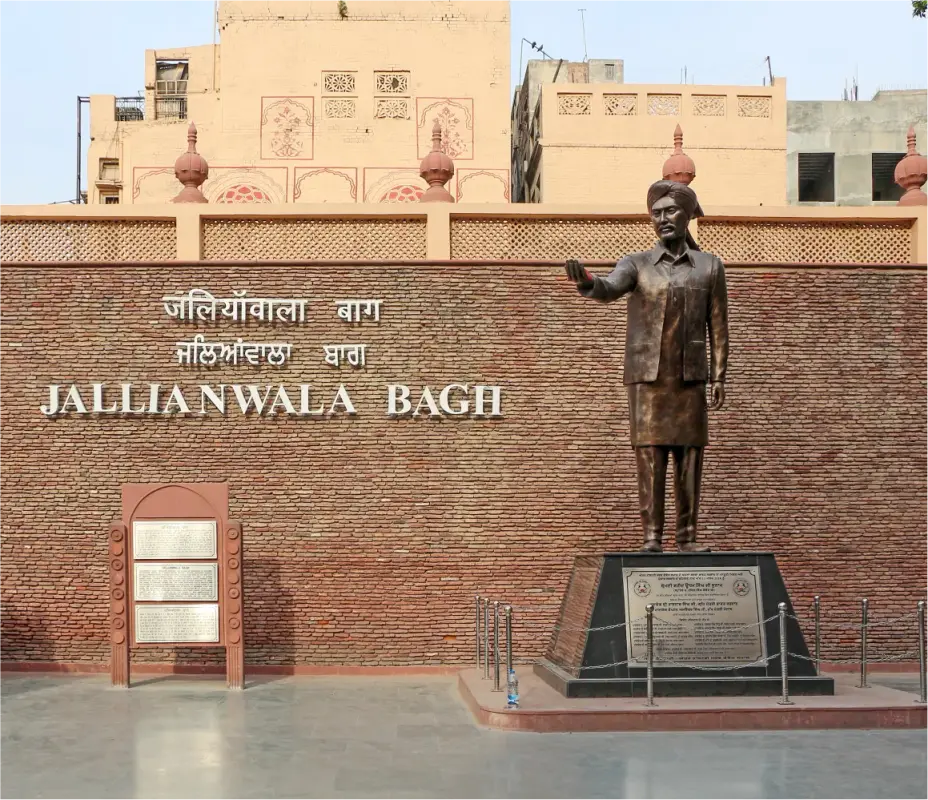
Jallianwala Bagh Memorial, Amritsar.
Image credit: Wikimedia Commons
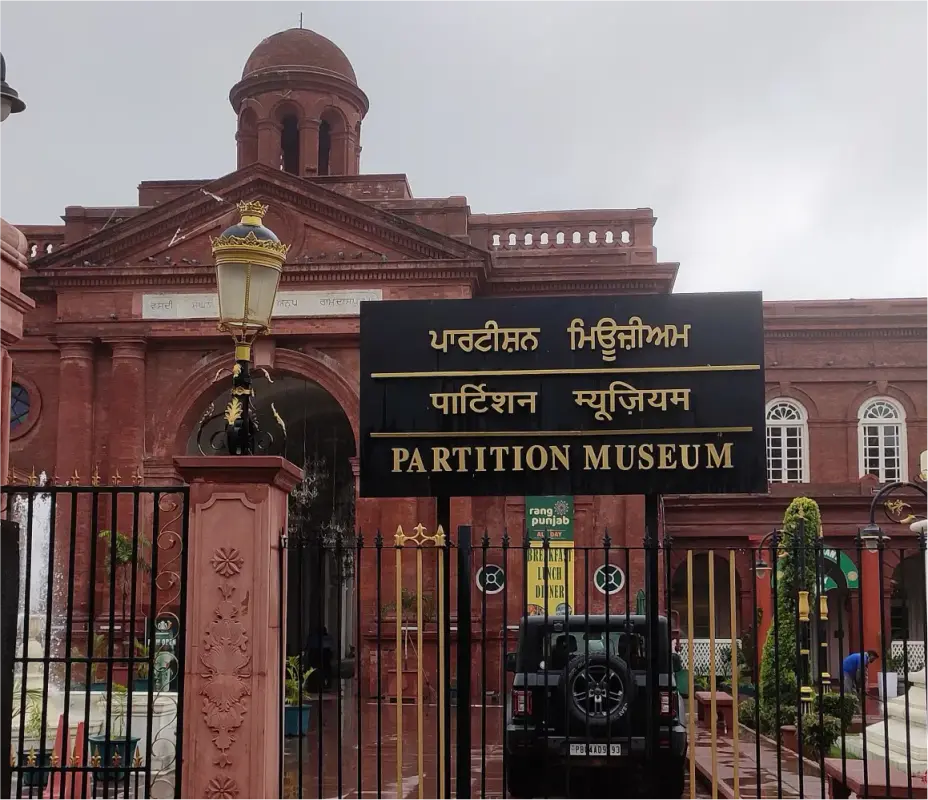
Partition Museum, Amritsar — dedicated to the memories of Partition 1947.
Image credit: Wikimedia Commons

Flag lowering ceremony at Wagah Border.
Image credit: Wikimedia Commons
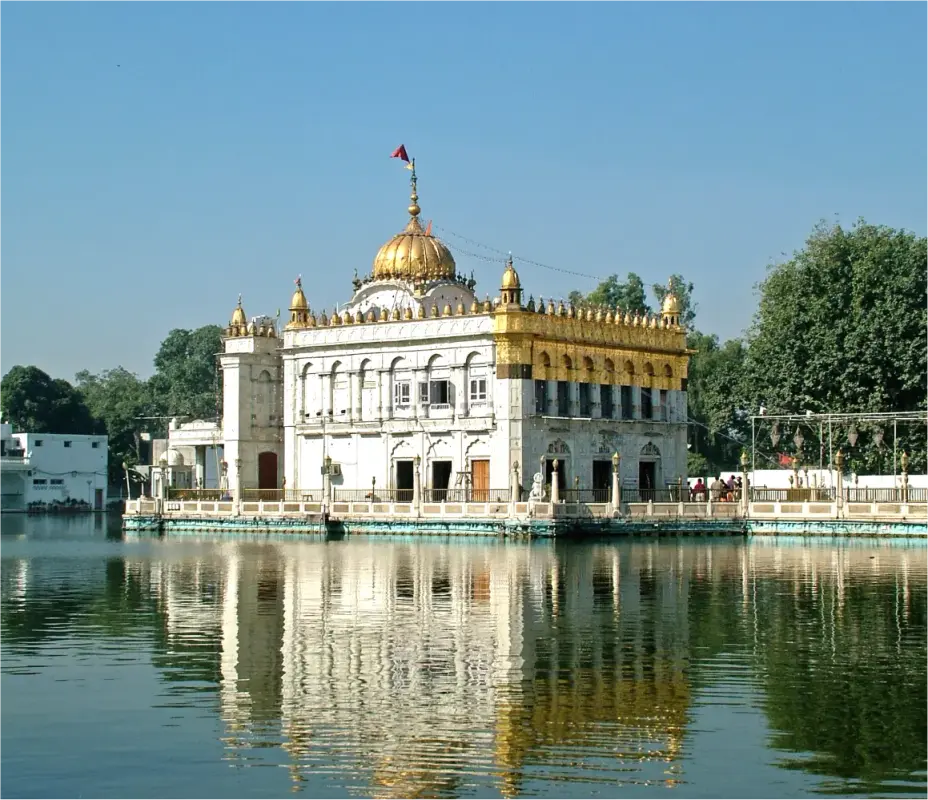
Durgiana Temple, Amritsar — also known as Lakshmi Narayan Temple.
Image credit: Wikimedia Commons
Local Experiences
- Participate in the langar service – either by eating or volunteering in cooking, serving, or washing dishes.
- Take a night walk around the lake when the temple is beautifully illuminated.
- Listen to the live kirtan (devotional music), which echoes throughout the complex, creating a spiritual atmosphere.
History and Background
Origin and Establishment
The foundation of the Golden Temple was laid in the late 16th century under the guidance of the fifth Sikh Guru, Guru Arjan Dev Ji. In 1577, the fourth Sikh Guru, Guru Ram Das Ji, excavated a sacred lake known as Amrit Sarovar. Around this sacred lake, the city of Amritsar was founded, which later became the cultural capital of the Sikh community.
Guru Arjan Dev Ji envisioned a central place of worship for the Sikhs that would reflect humility, equality, and openness. Unlike traditional temples built on elevated ground, the Harmandir Sahib was deliberately built at a low level, symbolizing humility and accessibility for all.
Construction Timeline
- 1581–1589: Excavation and expansion of the Amrit Sarovar.
- 1589: The foundation stone of the Harmandir Sahib is laid by Hazrat Mian Mir, a revered Sufi saint of Lahore – a feat that symbolizes interfaith harmony.
- 1604: Guru Arjan Dev Ji completes the structure and installs the Adi Granth (the first version of the Sikh scripture) in the sanctum sanctorum.
- 1760–1800: The temple was destroyed during Afghan invasions but was rebuilt several times by the Sikh community.
- 1830: Maharaja Ranjit Singh, the leader of the Sikh Empire, donated gold to cover the upper structure, giving it the iconic golden look it is celebrated for today.
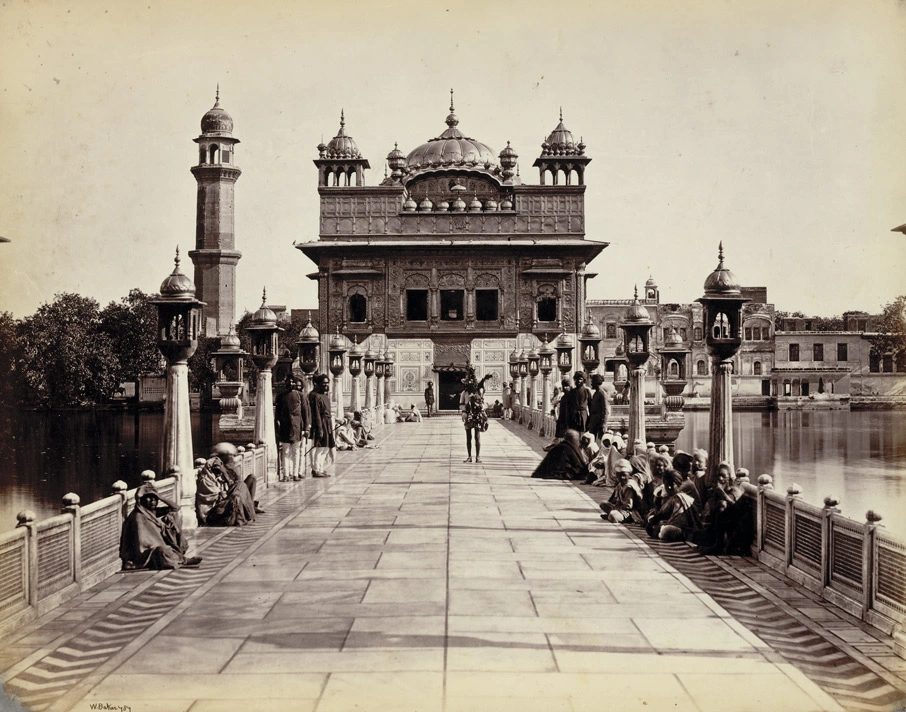
Entrance to the Golden Temple, Amritsar (1870). Image credit: Wikimedia Commons (Public Domain).
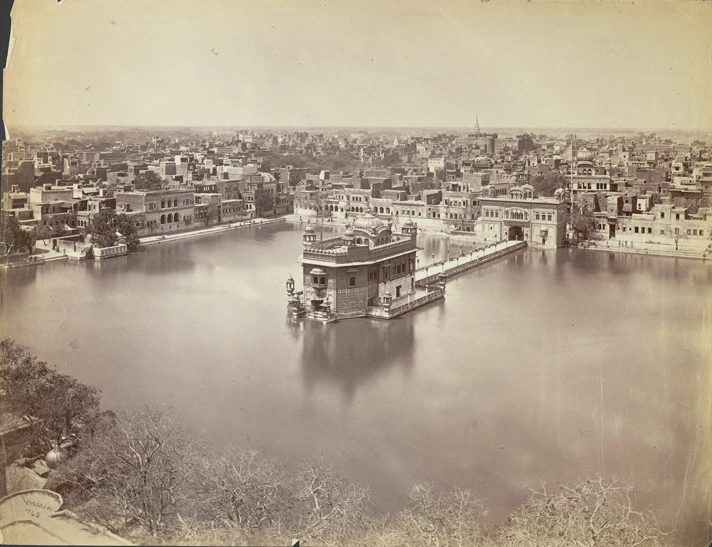
Golden Temple Darbar Sahib with sacred pool, Amritsar (ca. 1880). Image credit: Wikimedia Commons (Public Domain).
Historical Events and Stories
- Mughal Era: The temple faced hostility from Mughal rulers, especially during the reign of Aurangzeb, when the Sikh Gurus were persecuted.
- 18th Century: Afghan invaders like Ahmad Shah Durrani attacked Amritsar and damaged the temple, but the Sikhs worked tirelessly to rebuild it each time.
- Operation Blue Star (1984): The Indian Army attacked the temple to eliminate terrorists, causing tragic casualties and damage to the structure. The incident left deep scars in Sikh history but also strengthened the resilience of the community.
Legends and Myths
- A popular legend says that when Hazrat Mian Mir laid the foundation stone, he blessed the temple as a place of eternal peace.
- Some devotees believe that the holy waters of Amrit Sarovar have healing powers for both physical and spiritual ailments.
The journey from the Golden Temple to a global symbol of faith and resilience encompasses Sikh history, sacrifice, and devotion.
Architecture and Design
Architectural Style
The Golden Temple is a blend of Sikh, Mughal, Rajput and Indo-Islamic architectural influences. Unlike traditional Hindu temples with tall spires, the Harmandir Sahib has a unique low-rise profile, symbolizing humility. The sanctum sanctorum is surrounded by a rectangular marble path where pilgrims circumambulate the sacred temple, reflecting spiritual discipline.
The temple's dome is shaped like an inverted lotus, symbolizing a sense of seclusion and purity. The four entrances, one on each side, represent the Sikh principle of openness – welcoming people of all castes, religions and backgrounds.
Materials and Techniques
Built of original bricks and smooth lime mortar, the temple has undergone several reconstructions. During the reign of Maharaja Ranjit Singh in the early 19th century, craftsmen covered the upper part of the sanctum sanctorum with 750 kilograms of pure gold leaf, which gave it a prestigious shine. The lower walls are made of intricately carved white marble, studded with precious and semi-precious stones.
The interior of the sanctum sanctorum is decorated with frescoes, mirror work and pitra dura inlay, depicting detailed floral motifs, arabesques and verses from the Guru Granth Sahib. Gold-covered panels and intricate jalis (lattice screens) create an atmosphere of grandeur and devotion.
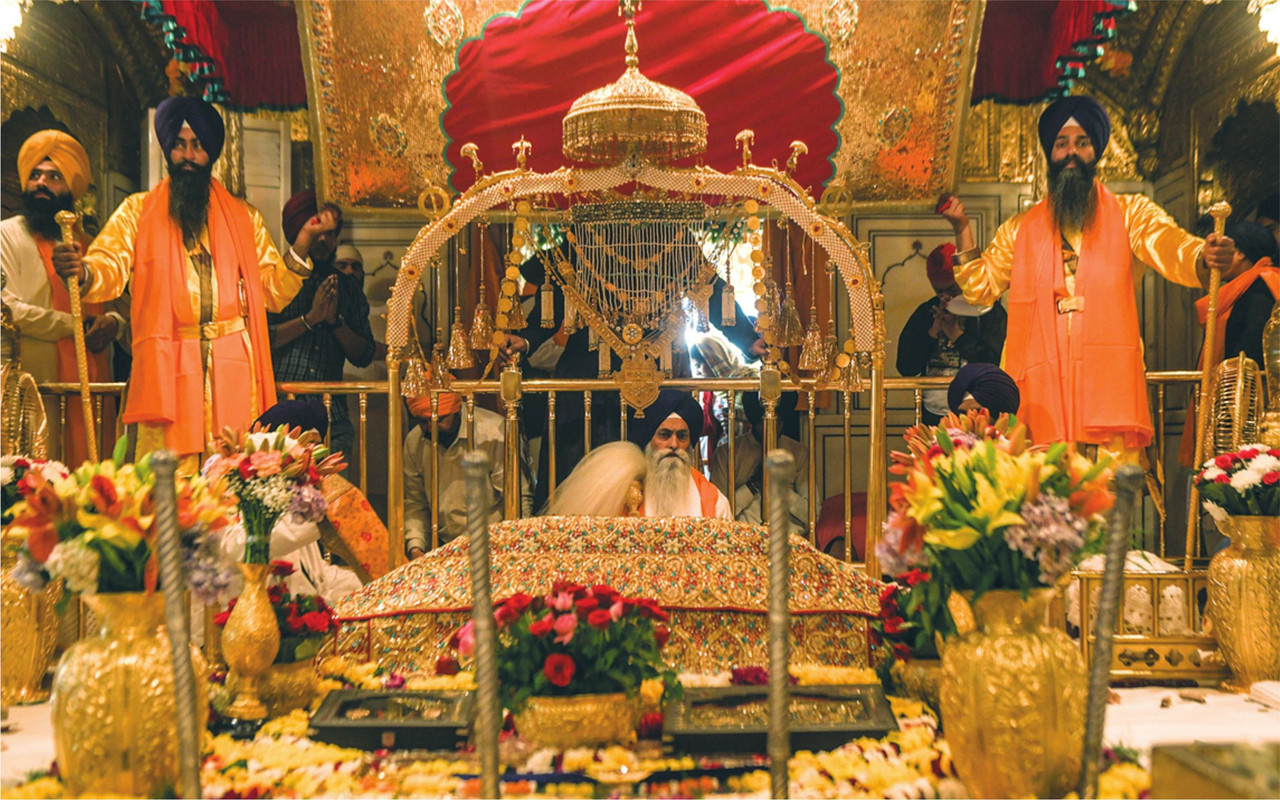
Interior of Golden Temple with Guru Granth Sahib
Image Credit: Punjab Tourism

Close-up view of Golden Temple golden walls
Image Credit: Punjab Tourism
Gardens and Surrounding Areas
The temple complex is centered around the Amrit Sarovar, a large man-made water tank filled with holy nectar-like water. Pilgrims bathe in the lake, believing that it purifies the soul. Surrounding the tank are marble walkways, whitewashed domes, and prayer halls.
Another important building within the complex, the Akal Takht, serves as the temporary seat of Sikh authority. Adjacent to it is the Langar Hall, where volunteers prepare and serve free meals to thousands of visitors each day. Lush gardens, tree-shaded resting places, and open courtyards complete the tranquil landscape.
Artistic Elements
Inside the abode, visitors are greeted by exquisite wall paintings, floral murals, and gold-plated ceilings. The domes gleam with delicate gold work, while the marble panels are carved with verses from Sikh scriptures. The combination of shimmering gold, reflective water, and spiritual chanting creates an experience that transcends architecture and becomes pure devotion.
Cultural and Spiritual Significance
Religious/Spiritual Significance
The Golden Temple is the holiest temple in Sikhism, similar to Mecca for Muslims or the Vatican for Christians. It houses the Guru Granth Sahib, the eternal Guru of the Sikhs, which is constantly recited in melodious hymns (kirtan).
The act of entering through any of the four gates represents equality and inclusiveness. The sanctum sanctorum is deliberately built at a lower level, requiring visitors to descend before entering, a symbol of humility. Bathing in the Amrit Sarovar is believed to purify one's soul of ego and sins.
Cultural Relevance
In addition to its religious significance, the Golden Temple represents the Sikh values of seva (selfless service), langar (community kitchen) and sarbat da bhala (welfare of all humanity). The langar here is the world's largest free kitchen, preparing over 200,000 meals daily during festivals. Volunteers from all over the world contribute regardless of their background, making it a living example of communal harmony.
The temple also plays a central role in Sikh festivals such as Vaisakhi, Diwali and Gurupurab. During these occasions, the temple is illuminated with thousands of lights, crackers and devotional music, attracting a large number of devotees and tourists.
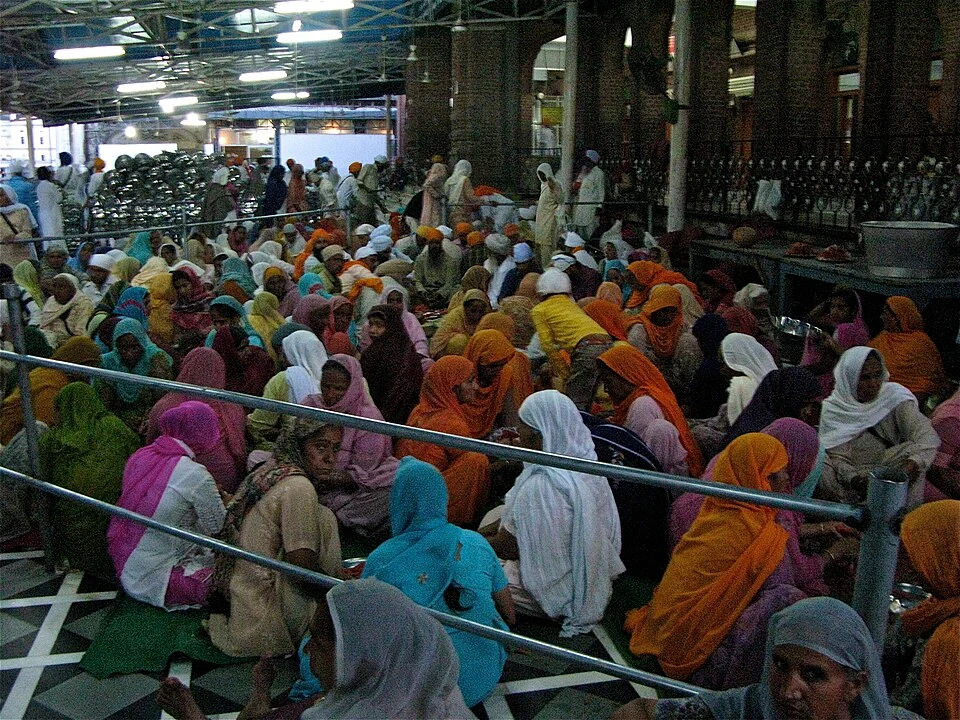
Volunteers serving langar at Golden Temple
Image Credit: Wikimedia Commons
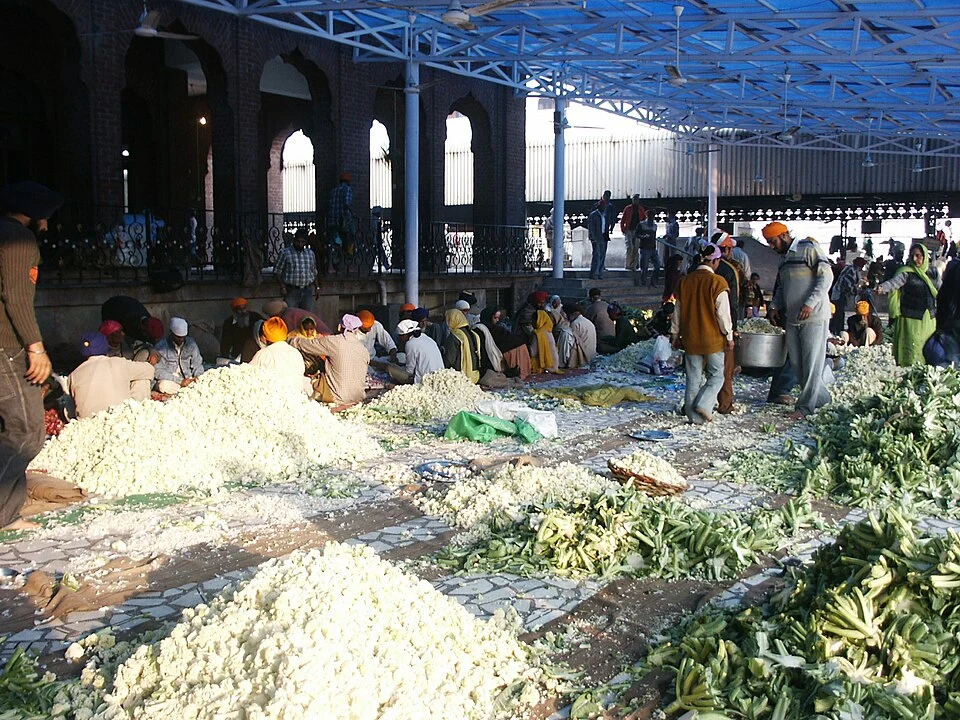
Food preparation by volunteers at Guru Ram Das Langar
Image Credit: Wikimedia Commons
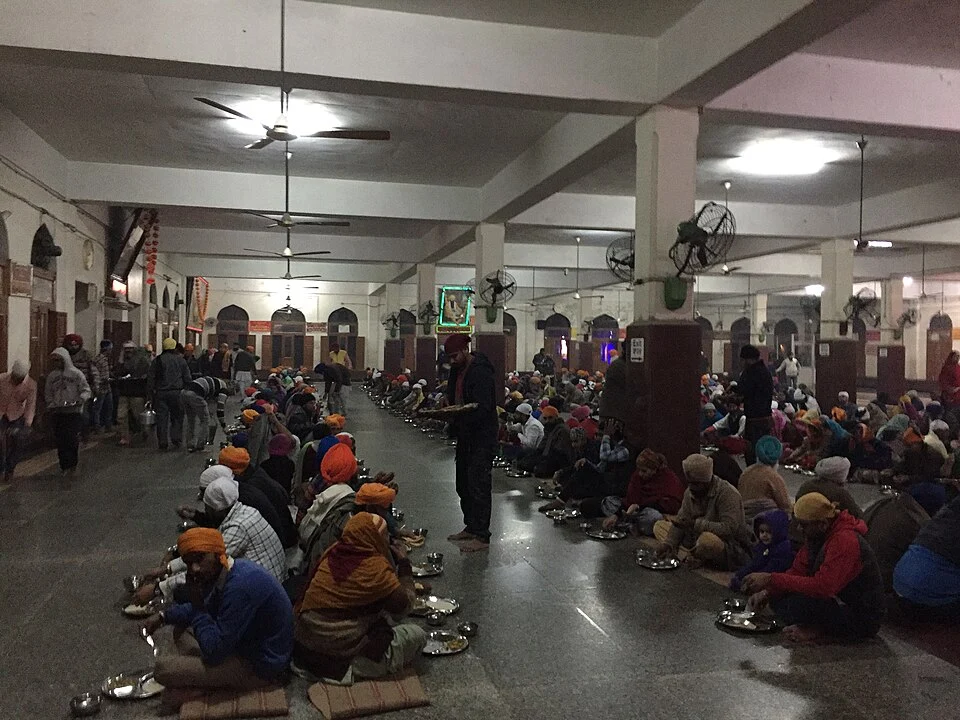
Devotees eating together at the Golden Temple Langar
Image Credit: Wikimedia Commons
Influence on Art and Literature
The Golden Temple has inspired countless poets, artists and musicians. Traditional Sikh devotional music, known as Shabda Kirtan, originates from here and is transmitted around the world. In literature, the temple is often depicted as a beacon of spiritual enlightenment and resistance to oppression.
Globally, the Golden Temple has become a cultural symbol of peace, resilience, and universal brotherhood, extending its significance beyond the Sikh community.
Fun Facts and Trivia
- The dome of the Golden Temple is gilded with 750 kilograms of pure gold, donated by Maharaja Ranjit Singh in the early 19th century.
- It is estimated that more than 100,000 people are served free meals every day, making the langar the largest community kitchen in the world.
- The temple has four entrances, indicating that people from all directions and regions are welcome.
- The Golden Temple receives more visitors every day than the Taj Mahal.
- UNESCO has recognized the area around Amritsar as a cultural heritage site.
- The Golden Temple is frequently depicted as a symbol of spirituality and resilience in Bollywood and international films, documentaries and books.
- An interesting legend says that the lake's waters have healing powers, and many devotees take a dip as part of their spiritual rituals.
Impact and Legacy
Global Recognition
The Golden Temple is not just a sacred Sikh temple but a global symbol of peace, humility and equality. It attracts more visitors each year than some of the world's most famous monuments. The temple's free community kitchen (langar) and its openness to people of all faiths make it unique in the global religious landscape.
Although not officially listed as a UNESCO World Heritage Site, the Golden Temple is widely considered one of India's most important spiritual and cultural landmarks. Its influence extends beyond Sikhism – leaders, dignitaries and celebrities from around the world have paid their respects here.
Influence on Modern Architecture
The design principles of the Golden Temple – symmetry, openness, water-centric planning and symbolic architecture – have inspired Sikh gurdwaras around the world. Temples in Canada, the UK and the USA often reflect elements of the layout of the Harmandir Sahib. The balance of simplicity and grandeur has impressed architects who study religious harmony in structural design.
Heritage and Preservation
Despite facing invasions, destruction, and tragic events such as Operation Blue Star (1984), the Golden Temple continues to shine as a symbol of resilience. Restoration efforts have always been made by the Sikh community itself, keeping alive the tradition of Kar Seva (voluntary service).
Today, the Golden Temple is more than just a historical monument – it is a living legacy, embodying the Sikh values of devotion, service, and equality. Its role as both a place of worship and a cultural landmark ensures its preservation for future generations.
Conclusion
The Golden Temple, with its gleaming golden dome reflected in the serene Amrit Sarovar, stands as a timeless beacon of faith, resilience, and inclusiveness. From its humble beginnings in the 16th century to its status as one of the world's most visited spiritual centers today, it continues to inspire millions.
For pilgrims, it is a sacred place where the Guru Granth Sahib resonates in emotional hymns. For tourists, it is a place of awe-inspiring beauty and unparalleled hospitality. And for humanity, it is a powerful reminder of the values of humility, service and brotherhood.
Whether you are seeking spirituality, culture or history, a visit to the Golden Temple is not just a journey – it is an experience of the soul.
Frequently Asked Questions About the Golden Temple
Question 1: Where is the Golden Temple located?
Answer: The Golden Temple stands in the city of Amritsar, situated in the Indian state of Punjab.
Question 2: Why is it called the Golden Temple?
Answer: Because its upper floors and domes are covered with real gold, which was donated by Maharaja Ranjit Singh in the 19th century.
Question 3: What is the best time to visit the Golden Temple?
Answer: October to March is ideal, although festivals like Diwali and Vaisakhi offer a special experience.
Question 4: Is there any entry fee for the Golden Temple?
Answer: No, entry is free for everyone, regardless of religion or nationality.
Question 5: What is langar at the Golden Temple?
Answer: It is the world's largest free community kitchen, serving food to over 100,000 people every day.

.webp)

